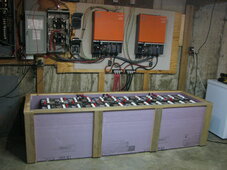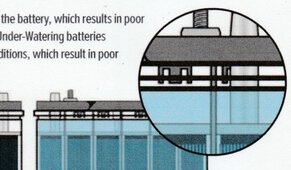Grateful Ed
New Member
- Joined
- Jan 16, 2022
- Messages
- 42
My battery bank was quite hot and gassing off in the middle of the night pumping out a fair amount of acid, I let the load continue to draw and waited until the morning to turn the system off (convenient to still have the grid). I disconnected the bank from the inverters via the breakers to let them chill out, they were running at about 100°+, mopped up the acid and let them cool down on their own. It has been nearly 24 hours and they are still lightly bubbling. I ignorantly had not protected the terminals when I installed it and have been cleaning corrosion off topically and intended to do what I am now which is disconnect everything, clean and de-acidify it and then reassemble properly. The only info I found regarding the continued gassing in the night was that maybe I had a bad cell and the other batteries were charging back to it but I disconnected one that was working away and it read 1.280 on the end cells and 1.275 in the middle. I didn't check the cell voltage yet but am relieved it looks happy. I will be recording every cell as I clean them. I have been periodically searching and still have not been able to get any real feel for when or how often I should do an equalization charge and stuff like that.
I have had the system on 100% since august of last year and had to charge the batteries externally twice over the winter due to extended dark periods of 14+ days but things seemed to work perfectly. I didn't record it but I think when I was charging them from the grid on new years eve each inverter was running at about 40A at 110V, they are rated as 100A charge controllers (@48v I would assume), they were cranking when I went to bed and all charged up by morning. I checked the levels monthly and barely put any water in it until last week when it took nearly a quart for the whole set. In these several days of blazing sun they appear to have boiled out a lot more. I have three freezers and two refrigerators running, a 1/2hp 220V well pump and use arbitrary power for the on demand hot water heater, microwave and toaster oven and have used my welders and other items periodically but during the day the panels are putting out enough to cover any of that so I think I am not leaning on the batteries much and as I designed it generally have all that juice stored for those extended dark periods.
It appears that they have been overcharging since the summer came with much longer sun exposure. I had thought the inverters would shunt the load when the batteries were topped regardless of how much sun they had. My 32 405W panels generate anywhere from 25 - 50A at 160 - 180V on good days, most bright winter days the batteries would be topped by 11am, by 2pm with light cloud cover.
I have 2 phocos 6.5kW inverters (same chassis as MPP or EG4) for split phase 220V, 24 Crown 390Ah 6V batteries in three parallel series of 8 for a 48V storage set. The inverters are set to factory specs for FLA charging voltages which looked pretty vanilla to me, but learning this stuff by the seat of your pants is a challenge. Guess I'll learn some more now.
I am thinking I need to make sure the batteries are balanced and then set my charging up with different values for summer and winter with a periodic equalization charge which I believe the phocos software accommodates.
Any help on any of this would be appreciated thanks. here's a pic of how its laid out, before I finished the series wiring and put the covers on everything.

I have had the system on 100% since august of last year and had to charge the batteries externally twice over the winter due to extended dark periods of 14+ days but things seemed to work perfectly. I didn't record it but I think when I was charging them from the grid on new years eve each inverter was running at about 40A at 110V, they are rated as 100A charge controllers (@48v I would assume), they were cranking when I went to bed and all charged up by morning. I checked the levels monthly and barely put any water in it until last week when it took nearly a quart for the whole set. In these several days of blazing sun they appear to have boiled out a lot more. I have three freezers and two refrigerators running, a 1/2hp 220V well pump and use arbitrary power for the on demand hot water heater, microwave and toaster oven and have used my welders and other items periodically but during the day the panels are putting out enough to cover any of that so I think I am not leaning on the batteries much and as I designed it generally have all that juice stored for those extended dark periods.
It appears that they have been overcharging since the summer came with much longer sun exposure. I had thought the inverters would shunt the load when the batteries were topped regardless of how much sun they had. My 32 405W panels generate anywhere from 25 - 50A at 160 - 180V on good days, most bright winter days the batteries would be topped by 11am, by 2pm with light cloud cover.
I have 2 phocos 6.5kW inverters (same chassis as MPP or EG4) for split phase 220V, 24 Crown 390Ah 6V batteries in three parallel series of 8 for a 48V storage set. The inverters are set to factory specs for FLA charging voltages which looked pretty vanilla to me, but learning this stuff by the seat of your pants is a challenge. Guess I'll learn some more now.
I am thinking I need to make sure the batteries are balanced and then set my charging up with different values for summer and winter with a periodic equalization charge which I believe the phocos software accommodates.
Any help on any of this would be appreciated thanks. here's a pic of how its laid out, before I finished the series wiring and put the covers on everything.








